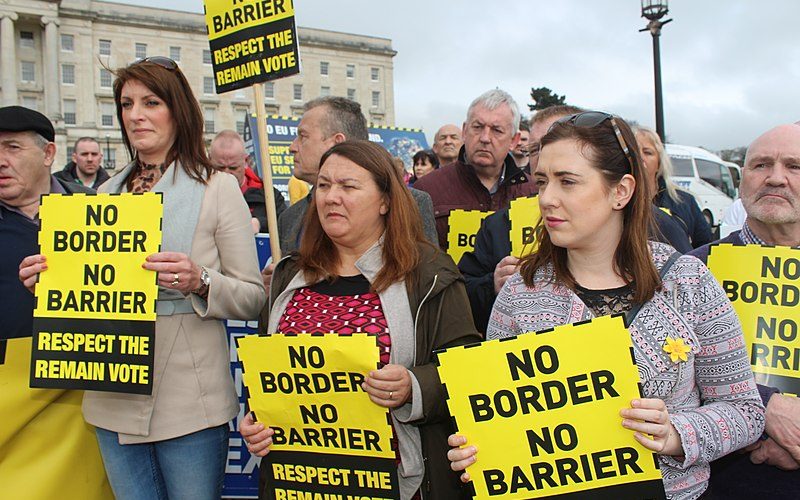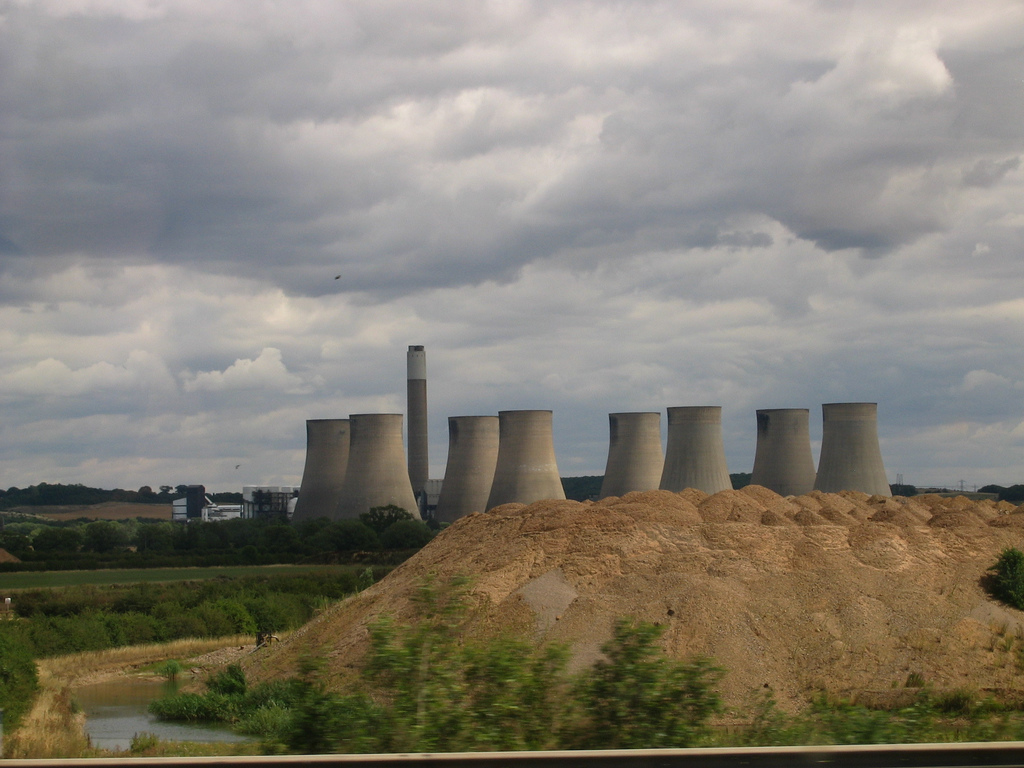During the 2016 Brexit referendum, Northern Ireland voted to remain in the European Union (EU) with 56 percent of the vote, but the United Kingdom (UK) as a whole voted to leave, with 52 percent of the vote.
While the Irish border problem was not a talking point in the initial Brexit debate, it quickly emerged as one of the biggest problems facing former Prime Minister Theresa May, and now Prime Minister Boris Johnson in getting the British Parliament to ratify a deal with the EU. Prior to beginning negotiations, May stated that one of her priorities was to fully leave the EU single market and customs union. She also promised a “frictionless border in Ireland.”
Attempting to achieve these two objectives together proved not only impossible for May’s ministry, but also polarizing. Many hardliners and unionists—those who want Northern Ireland to remain a part of the UK and were generally pro-Brexit—fear that this issue will keep the UK, and specifically the Republic of Ireland, in a close relationship with the EU indefinitely and consider it a threat to Northern Ireland and the UK’s union. Conversely, nationalists—those who want closer relations with the Republic of Ireland and were generally pro-remain—see the issue as evidence that the “Leave” campaign was unrealistic.
Since becoming Prime Minister, Johnson has said he plans to renegotiate May’s Brexit deal, primarily to remove the “Irish backstop.” On October 21, the UK and EU agreed upon a new deal without the backstop. If the UK fully leaves the EU customs union and single market, Northern Ireland and Ireland will be following completely different rules and regulations, necessitating a physical border, potentially aggravating existing tensions, and threatening the relatively new peace. Regardless of whether a deal for Brexit is eventually achieved, the Irish border problem will transform the UK and EU as we know them.
Brexit threatens to renew a centuries-long conflict and is already straining the relatively new peace. There is a long history of both English and Scottish involvement in Ireland, with continued implications into the present-day. The Protestant-controlled Irish Parliament gained legislative independence from Great Britain in 1782, but attempted rebellion in 1798 caused both the British and Irish parliaments to pass the Acts of Union in 1800. This resulted in the merging of their parliaments and the creation of the United Kingdom of Great Britain and Ireland.
Throughout the 1800s, many Irish were strongly opposed to this union and frequently attempted to revolt and repeal the union. For example, the Young Ireland movement grew out of another nationalist movement during the Great Famine (1845-1849). The Young Irelanders originally hoped to create a non-sectarian public opinion based in Irish cultural nationality, but their goals shifted to the establishment of an independent Irish republic through revolution.
During the Anglo-Irish War (1919-1921), the British Parliament passed an act in 1920 that partitioned Ireland into Northern and Southern Ireland; “each was given a degree of local control over its territory, but both were still formally part of the United Kingdom.” Most Irish in the south wanted complete independence, rather than limited local control, but the 1922 peace treaty that established the Irish Free State stopped short of that. The Irish Free State became “Ireland” in 1937, and when it left the British Commonwealth in 1949, it became the “Republic of Ireland.” At this point, the border between Ireland and Northern Ireland became an international one, which hardened over time.
Northern Ireland specifically became even more divided in the 1950s and 1960s, particularly due to segregation and religious tensions between Catholics and Protestants. The Catholic minority pushed for greater civil rights in the 1960s, but their originally peaceful movement turned violent, causing the British military to respond with harsh crackdowns. Paramilitary groups on both sides, such as the Provisional Irish Republican Army and the Ulster Volunteer Force, eventually took matters into their own hands, and “the Troubles” began. “The Troubles” were “decades of political violence marked by bombings, sniper fire, and a civilian population that was both polarized and terrorized.” During this time, the Irish border became a heavily fortified battleground and a symbol of the violent communal struggle.
The 1990s witnessed the first peace talks, but violence continued until 1998, when both parties signed the Good Friday Agreement. This agreement “set up a power-sharing arrangement for Northern Ireland, giving both nationalists and unionists a share in government.” As a result, the paramilitary groups agreed to stop using violence and participate in this democratic process. While Ireland remained independent and Northern Ireland remained part of the UK, an open border has been a crucial aspect of the peace process.
The EU’s single market also helped with this process because it meant that border and customs checks were unnecessary along the Irish border, and the EU has continued to provide an avenue for communication and de-escalation. For example, after the 1998 Good Friday Agreement, the rules set by the creation of the European single market in 1993 helped strengthen the all-island economy, especially in agriculture. The Good Friday Agreement and the European single market are both important aspects of the still-new peace. Brexit thus “appears to put the fundamental structure of the fragile peace process into question, by removing its central structural support.”
The “Irish backstop,” which Johnson has removed in the newest “divorce deal” with the EU, was a significant and confusing aspect of Theresa May’s deal. Prior to beginning negotiations with the EU, May set out her priorities, including leaving the EU’s customs union and single market and keeping a frictionless border in Ireland—two goals which are in fact, contradictory.
The backstop was a form of “insurance policy in the EU-UK withdrawal agreement that no matter what happens post-Brexit, the two sides will avoid a hard Irish border.” Specifically, it said that the entire UK will remain in a customs arrangement with the EU if there is no better solution by the end of the transition period.
There is currently nothing along the Irish border, and it is hard to tell when you move from one country into the other. This was one of the promises made to nationalists in Northern Ireland during the peace process. But “Brexit, and the hard border that may come with it, betrays that promise,” acting as a British rejection of the peace process just twenty years after it began. As a result, Johnson’s plans to remove the backstop protocol have drawn significant criticism from both nationalists and unionists.
Further complicating the situation, the EU has been hesitant to accept any plan without the backstop. It considers a “fully operational solution in the withdrawal agreement to avoid a hard border on the island of Ireland, protect the all-island economy and the integrity of the single market” essential. While Brexit will be particularly impactful in the Republic of Ireland due to concerns over the Irish border, it will also impact areas throughout the EU, particularly in terms of agriculture, trade, and migration.
Brexit may also affect the EU’s foreign policy, security, and defense. The UK is a large contributor to the EU budget, a nuclear power, and a permanent United Nations Security Council member and, as a result, strongly influences the EU’s foreign policy. Without the UK’s focus on such issues, coupled with possible consequences of a more disjointed union, the EU is likely to focus more on internal challenges to “bounce back” from Brexit. Some, like the Dahrendorf Forum’s 2016 Foresight Exercise that provides possible scenarios of the EU’s global role in 2025, see Brexit as leading to a “profound neglect of any coherent [EU] foreign policy strategy.” The full effects of Brexit on EU foreign policy remain to be seen, but is still an area of great concern. Furthermore, a no-deal Brexit, and the increased uncertainty associated with such an event, would likely exacerbate these potential effects.
In order to prevent the uncertainty created by the UK leaving the EU literally overnight, the UK Parliament has to ratify Theresa May’s Brexit deal. That is, unless Johnson is able to renegotiate, in which case Parliament will have to ratify his new deal by October 31. Parliament rejected May’s deal by 230 votes in January, by 149 votes in early March, and by 58 votes in late March. In May, the EU approved a further extension until October 31 so that the Prime Minister had more time to gain Parliament’s approval.
Johnson has consistently stated that he is “committed to leaving on 31 October come what may,” even if that means a no-deal Brexit. Johnson was a key figurehead in the Vote Leave campaign leading up to the 2016 referendum, and since becoming prime minister, has repeatedly promised that the UK will leave the EU on October 31 regardless.
However, recent developments mean that this promise will go unfulfilled. Members of parliament (MPs) passed the Benn Act to prevent a no-deal Brexit and forced Johnson to request another extension from the EU on October 19. On the same day, MPs passed an amendment in regards to Johnson’s proposed plan, which stated that support of the deal would be withheld until implementation legislation has been passed by both chambers of Parliament. To comply with the Benn Act, Johnson sent an unsigned letter to the EU requesting a further extension, but also sent a signed follow-up letter noting his disagreement with an extension. The EU approved this request and granted an extension until January 31, 2020. Thus, the chance for a no-deal Brexit is still present.
Overall, the economic relationship between the EU and the UK will change regardless of Brexit’s final form, but if there is a no-deal Brexit, that change could be very drastic. The Irish border will become the “only land border between the EU and the UK,” potentially causing both logistical and communal problems.
Currently, there are about 300 crossings on the 310-mile border, and a no-deal Brexit or a deal without the backstop would require customs checks to be implemented across the border. Peace is still new and militant groups still exist, and they could target customs checks along the border, possibly requiring another fortified border. A car bomb explosion in Derry, Northern Ireland in January reminded people of the threats of “the Troubles,” and foreshadowed a possible post-Brexit return to violence on the island if the Irish border is not adequately addressed.
Northern Ireland voted to remain in the EU in the 2016 referendum, and the 1998 Good Friday agreement “included an option for a future border poll on a united Ireland.” A no-deal Brexit may lead Northern Ireland and Ireland to consider reunification. The negotiation process would of course be complicated and take a great deal of time. However, if Ireland were to reunite, Johnson and his supporters will have not only caused Britain to leave the EU, but Northern Ireland to leave the UK.



